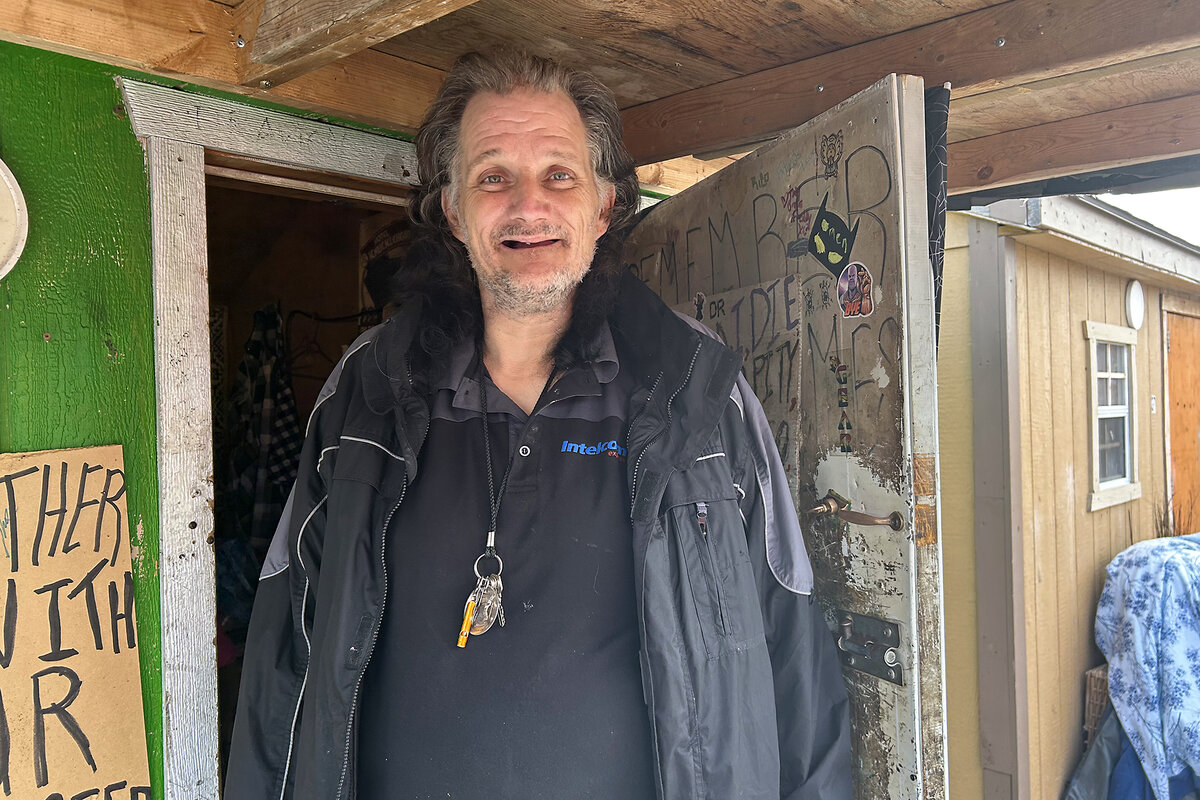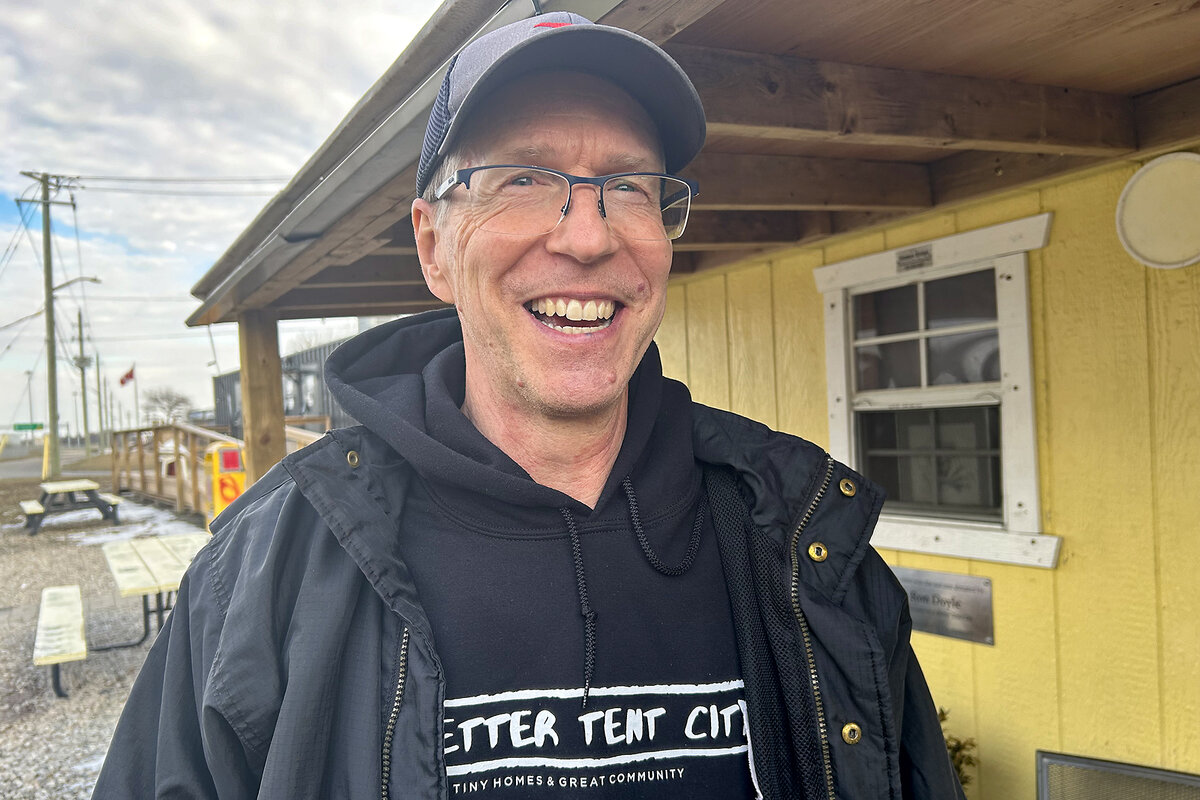For this affordable-housing advocate in Ontario, tiny homes are where the heart is
Loading...
| Kitchener, Ontario
When Nadine Green walks the pathway of tiny homes erected in two rows on a small patch of grass at the outskirts of this city, everyone seems to have something to ask or tell her.
For this community of formerly homeless people now each living in their own little house – really, a garden shed with a lockable door – Ms. Green helps with accessing services and resolving disputes. But mostly people just want to chat, and more interactions than not end in a hug. After all, her technical title might be site coordinator, but to most, she’s known as “Mom.” The word is scribbled on the door of her own home in the community.
This prefab village is A Better Tent City, a project to try to address homelessness on streets and in shelters and encampments – a hot-button political issue in Canada – by creating tiny communities that residents can consider their own. When it opened in 2020 here in Kitchener, some 70 miles west of Toronto, it was the first of its kind in Canada, but it has since inspired similar projects across the country. Its leaders have been contacted by dozens of groups interested in replicating the model.
Why We Wrote This
A story focused onMuch of Canada’s homeless population lives in encampments. Thanks to Nadine Green, some are finding community in villages made of tiny houses, where they can have their own homes.
But for Ms. Green, who lives in the community as part of her duties as site coordinator, success was never in doubt. “We always knew it was going to work,” she says – because it was her experience running a similar community in a convenience store she used to own that inspired the model in the first place.
“She took action”
Amid an affordable-housing crisis, homelessness is a serious concern in Canada. The country faces one of the biggest gaps for developed countries between home prices and income levels. In cities, tent encampments have cropped up and polarized communities, especially since the COVID-19 pandemic. One report says that 20% to 25% of homeless people live in encampments today.
Tiny homes are seen as one solution.
Ms. Green didn’t have the land or the funds to found A Better Tent City, but it was her support of the homeless community of Kitchener that laid the foundation of the project.
Ms. Green, who in her teens immigrated to Canada from Jamaica with her mother, always wanted to run a convenience store – the kind of establishment back home where shoppers were not customers but community. Those without cash could run a tab and pay what they owed when their paychecks arrived.
When she opened a store a decade ago in the center of Kitchener, it was right where a homeless population had congregated. Shopkeepers warned her about what they called a nuisance. She opened her doors instead, giving the homeless community free apples and bread, and a place to warm up.
More kept coming, and then some began staying the night. At its peak, the convenience store housed up to 40 people on any given night. Some slept in Ms. Green’s back office, or under a pool table in the store. Sometimes she slept there too, happily.
In January 2020, her convenience store was evicted; she didn’t have the right license to run it as a shelter. But she had caught the attention of a local entrepreneur with ties to the city.
Ron Doyle, who has since died, envisioned creating a village for those without homes – a place where they could live on their own terms – and first offered space in a conference center that was struggling amid the pandemic. He asked Ms. Green to run it and to find the residents to populate it.
Today, A Better Tent City comprises 42 homes. The nonprofit, run with grants and donations and a steady stream of volunteers, includes communal bathrooms, a kitchen, a lounge, and laundry rooms.
Matthew Robb, who goes by the name Dragon, wears the keys to his house around his neck. As a resident here, he takes part in cleaning the showers and helps with nighttime security, and in turn feels part of something bigger. “[When] you’re being judged, shunned by [society],” he says, “actually being part of a community, you feel so much better.”
Dan Bednis, chair of the board of the Hamilton Alliance for Tiny Shelters, says Ms. Green has been critical to inspiring groups like his. “She was appalled at the stigma faced by the unhoused, and she took action as a concerned citizen. Instead of talking about it, she did something about it,” he says. “She’s in my book like an angel. She’s our Mother Teresa.”
“I don’t know where I’d be without her,” says Mike Tughan, who once lived at Ms. Green’s convenience store.
Combating isolation
It’s not that all is perfect in this humming community, says Jeff Willmer, Kitchener’s former chief administrative officer who sits on the board of A Better Tent City. Drugs continue to pose one of the greatest challenges, he says.
But small signs of success abound, such as residents decorating their front entrances and making home improvements. And the way they measure success has slowly evolved too, he says.
While they still hold the ideal of housing for all, they have also learned lessons about what a successful community is, he explains. Providing the privacy of a home organized around communal space has been a model that combats isolation. “I think we can learn something from this about how we design supportive housing,” Mr. Willmer says. “So maybe it needs to look more like a lodging house and less like an apartment.”
As he’s talking, the laundry machine in the common space is whirring. A volunteer cook pulls out hot cross buns from the oven. Ms. Green steps away often to field calls and queries. When she has a moment, she explains her definition of success.
She describes a text she received the day before, from a grandmother inquiring about her granddaughter, a resident, to make sure she was OK.
“I went right to [the granddaughter] and said, ‘You need to message your grandma.’ ‘Oh, I’ll do it later,’ she said. And I said, ‘Do it right now.’”
The grandmother wrote Ms. Green back immediately, an effusive expression of gratitude just to know her family member was alive. “That is pure love; that is worth more than anything,” Ms. Green says.








